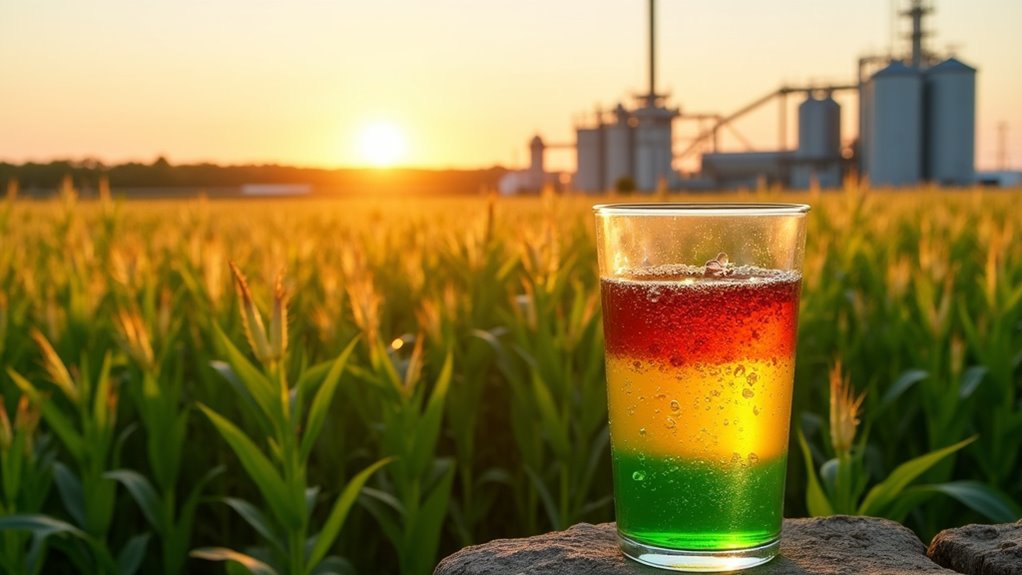Biofuels are renewable energy sources made from organic materials like plants, algae, or waste, offering a cleaner alternative to fossil fuels. You’ll find ethanol, mainly from corn or sugarcane, as the most common biofuel, while biodiesel is produced from fats and oils. Advances also include renewable diesel, made through chemical processes. These fuels are evolving rapidly, with innovative methods and new feedstocks promising cleaner, sustainable options—discover how these developments are shaping tomorrow’s energy landscape.
Key Takeaways
- Biofuels are renewable fuels derived from biomass such as crops, algae, or waste, used to replace fossil fuels in transportation.
- Ethanol, mainly produced from corn or sugarcane via fermentation, is the most common biofuel for blending with gasoline.
- Biodiesel is made through transesterification of vegetable oils or animal fats, producing renewable diesel with similar properties to petroleum diesel.
- Advanced biofuels, including renewable diesel and jet fuels, are produced via hydrotreating and catalytic processes from various feedstocks.
- The development of second- and third-generation biofuels aims to increase yield, reduce costs, and minimize environmental impacts for sustainable energy use.
What Are Biofuels and How Are They Made?
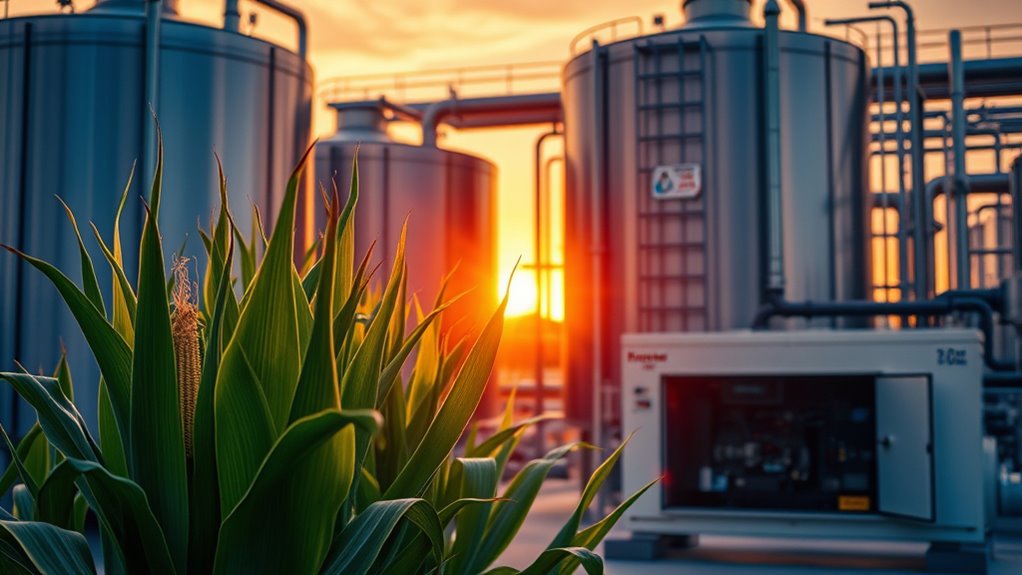
Biofuels are fuels made from biomass sources like plants, algae, or animal waste. They’re considered renewable because the feedstocks can be replenished quickly, unlike fossil fuels such as petroleum or coal. This renewable nature makes biofuels a key component of sustainable energy strategies. You mainly find biofuels produced from wood, crop residues, food crops, and organic waste. Algae is gaining attention because it grows fast and has a high energy content, making it a promising third-generation source. To turn biomass into usable fuels, manufacturers use different conversion processes. Biochemical methods, like fermentation, break down sugars into ethanol, while thermochemical processes—such as pyrolysis or gasification—decompose biomass at high temperatures. Hydrothermal liquefaction is especially effective for wet biomass like algae, producing bio-crude oil with moderate heat and pressure. Additionally, advancements in feedstock processing are improving conversion efficiency and sustainability.
Ethanol: the Most Common Biofuel Derived From Crops

Ethanol stands out as the most widely produced biofuel derived from crops, especially in countries like the United States and Brazil. You mostly get ethanol from starch-rich crops such as corn in the U.S. and sugarcane in Brazil. Production mainly uses the dry-grind method, which accounts for 67% of U.S. ethanol, while wet milling yields co-products like gluten meal, corn oil, and DDGS for animal feed. Microorganisms like Saccharomyces cerevisiae yeast ferment the sugars into ethanol, with bacterial enzymes helping break down cellulose. Byproducts like lignin power plants, and CO₂ is a key emission during fermentation. Efficient processes, including dehydration and water recycling, improve output and sustainability.
| Feedstock | Process | Microorganisms |
|---|---|---|
| Corn | Dry-grind method | Saccharomyces cerevisiae |
| Sugarcane | Fermentation | Bacterial enzymes |
| Sorghum/Barley | Wet milling | Genetically modified strains |
| Starch crops | Saccharification | Thermophiles (explored) |
| Biomass | Pretreatment | Contamination control |
Cellulosic Ethanol and Its Sustainability Benefits

Have you ever considered how cellulosic ethanol offers a more sustainable alternative to traditional fuel sources? This biofuel is made from plant biomass like agricultural residues and energy crops, not food crops, making it more eco-friendly. It markedly reduces greenhouse gas emissions and has a lower carbon footprint since it uses waste material and marginal lands unsuitable for farming. By utilizing biomass waste, it helps preserve biodiversity and requires less water than conventional farming. Cellulose is the stringy fiber of plants Technologically, it involves processes like biochemical and thermochemical conversion, which are complex but improving. Although initial costs are high, government incentives support its growth. As advancements continue, biofuel technology promises a cleaner, more sustainable fuel option that benefits the environment and reduces reliance on fossil fuels.
Biodiesel: Transforming Fats and Oils Into Engine Fuel

Biodiesel is produced through a chemical process called transesterification, where vegetable oils or animal fats react with short-chain alcohols like methanol or ethanol in the presence of a catalyst. Typically, about 100 pounds of oil or fat combine with 10 pounds of alcohol and catalyst, yielding 100 pounds of biodiesel and 10 pounds of glycerin by-product. This process requires careful control of temperature, mixing, and purity to ensure high-quality fuel and minimize impurities. Catalysts such as sodium hydroxide or potassium hydroxide accelerate the reaction, which converts triglycerides into fatty acid methyl or ethyl esters—biodiesel—and glycerol. Feedstocks include vegetable oils like soybean, canola, palm, and animal fats like tallow or lard, with waste oils also used to boost sustainability. Proper purification removes impurities, ensuring biodiesel meets fuel standards and performs efficiently in engines. Ensuring proper purification is crucial for meeting quality standards and achieving optimal engine performance. Additionally, advancements in refining techniques continue to improve the overall quality and environmental benefits of biodiesel.
The Four Generations of Biofuels and Their Differences

Have you ever wondered how different types of biofuels are classified? The classification is based on their sources and production methods. First-generation biofuels come from edible crops like vegetables and sugar, using existing infrastructure but limited in scale and competing with food production.
Second-generation biofuels use non-edible biomass such as agricultural waste and forestry residues, offering better scalability and lower greenhouse emissions, though they involve complex processes. These fuels often utilize high fiber content to produce bioenergy efficiently.
Third-generation biofuels utilize algae and microorganisms, which can grow on non-arable land and produce high oil yields, but are still costly.
Fourth-generation biofuels focus on genetic engineering to improve efficiency and create low-emission fuels, aiming for long-term sustainability.
Each generation reflects advancements in technology and environmental impact, shaping the future of biofuel development.
Renewable Diesel: A Drop-In Fuel Chemically Similar to Petroleum
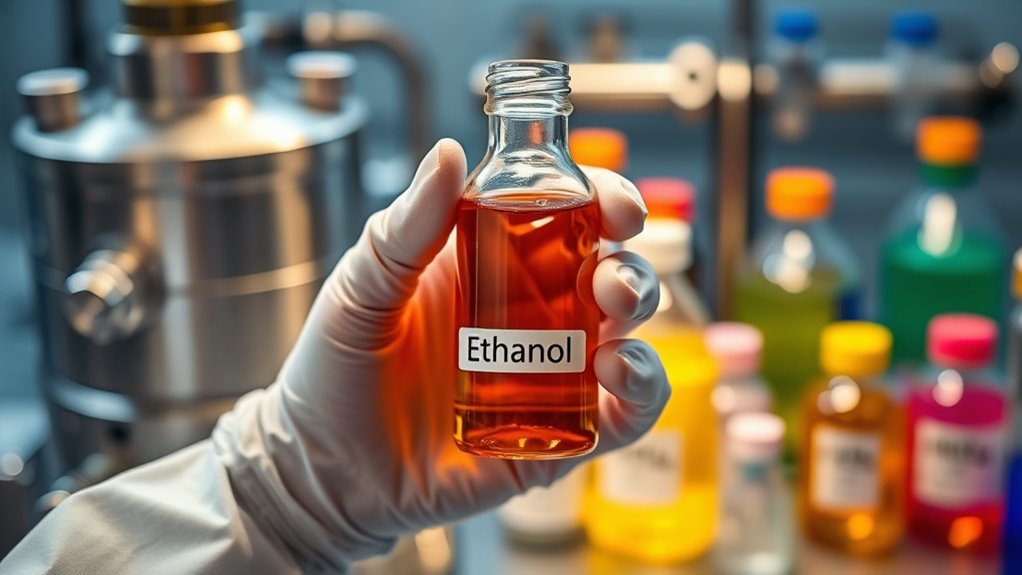
Renewable diesel, also known as green diesel, is a hydrocarbon fuel that closely resembles petroleum diesel in both chemical makeup and performance. It’s produced mainly through hydrotreating organic feedstocks like vegetable oils and animal fats, resulting in a fully refined, drop-in fuel compatible with existing infrastructure. Unlike biodiesel, renewable diesel is free of oxygen, sulfur, and aromatics, leading to cleaner combustion, higher cetane (75–90), and lower emissions. It meets ASTM D975 standards, allowing seamless engine integration. Its chemical similarity means you can use it directly without modifications, benefiting engine longevity and performance. Additionally, renewable diesel’s renewable feedstocks contribute to reducing the carbon footprint of transportation fuels. Here’s a quick overview:
| Feature | Renewable Diesel | Petroleum Diesel |
|---|---|---|
| Composition | Hydrocarbon | Hydrocarbon |
| Oxygen Content | None | None |
| Sulfur | Low | Varies |
| Cetane | 75–90 | 40–45 |
| Production | Hydrotreating | Refining |
Thermochemical Conversion Processes for Biofuel Production
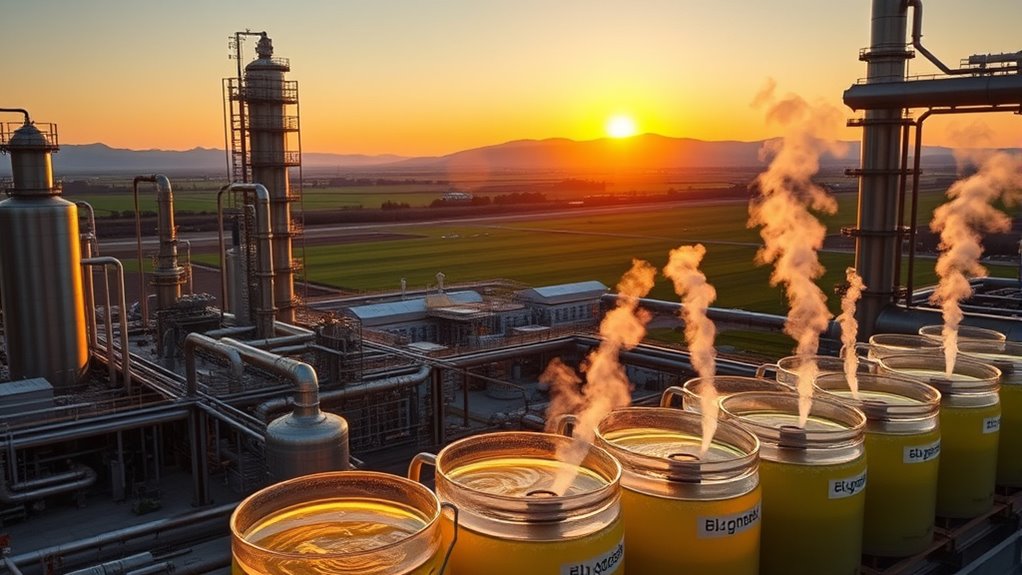
Ever wondered how biomass can be transformed into usable biofuels? Thermochemical conversion processes make this possible by breaking down organic materials at high temperatures.
Pyrolysis heats biomass without oxygen, producing bio-oil that can be refined into fuels.
Gasification transforms biomass into syngas, a mixture of carbon monoxide and hydrogen, which can be converted into various fuels.
Liquefaction uses high pressure and moderate temperatures to turn biomass directly into liquid fuels.
Torrefaction slightly heats biomass to reduce moisture, making it easier to store and transport.
These processes utilize diverse feedstocks like agricultural residues, algae, and energy crops.
They allow for efficient biomass use, generate different biofuels like ethanol, butanol, and synthetic hydrocarbons, and offer a low-carbon alternative to fossil fuels.
Advantages and Challenges in Scaling Up Biofuel Technologies
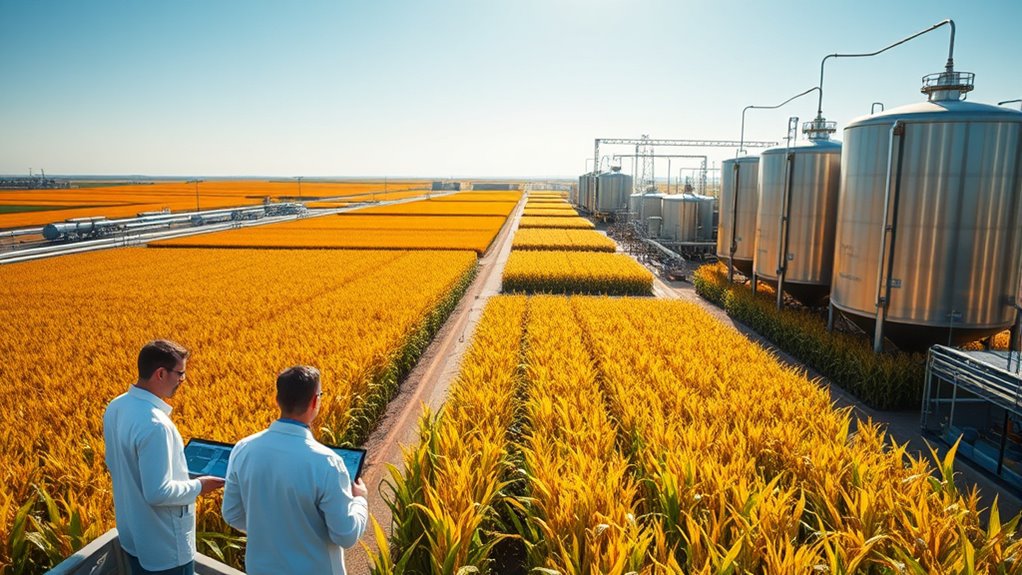
Scaling up biofuel technologies offers promising solutions for reducing dependence on fossil fuels, but it also presents significant challenges that must be addressed. Securing sustainable feedstock supply is essential; however, crop yields, land use, and logistics complicate consistent collection and processing.
The bulky, variable nature of biomass increases costs and requires robust pre-treatment systems. Economically, second-generation biofuels are 2 to 3 times more expensive than petroleum, with high capital and operating costs, making profitability uncertain without subsidies.
Technologically, scaling involves complex process development, handling diverse feedstocks, and improving energy efficiency. Infrastructure gaps in storage, distribution, and standards hinder widespread adoption. Effective planning is crucial for overcoming these hurdles and ensuring long-term viability.
Overcoming these obstacles demands coordinated efforts, innovative solutions, and supportive policies to make large-scale biofuel production feasible and sustainable.
Innovations Driving Next-Generation Biofuels
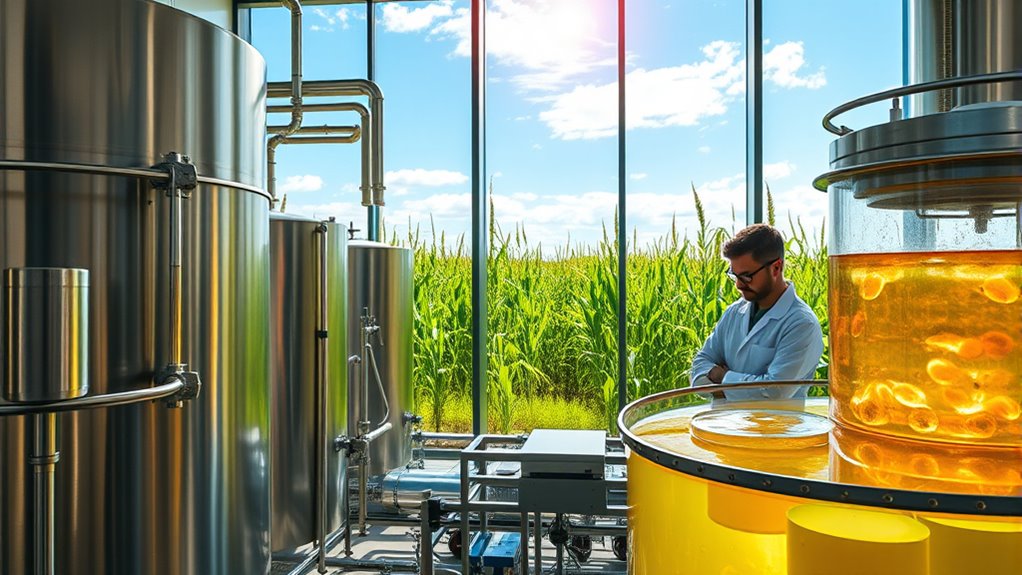
Innovations in next-generation biofuels are transforming the landscape of sustainable energy by harnessing advanced feedstocks and cutting-edge conversion technologies. You’ll see researchers exploring fast-growing seaweed as a sustainable, non-land-competitive source, while bacteria and fungi are being engineered to produce high-yield biofuel precursors. Expanding feedstock options such as agricultural residues, algae, and waste materials are also gaining attention to avoid food crop competition and reduce land-use impacts. On the technology side, catalytic systems now convert ethanol into renewable diesel and jet fuel more efficiently, with bioengineering creating organisms that boost yields and cut costs. Additionally, integrated carbon capture and utilization—using renewable hydrogen and waste CO₂—aim to make biofuels more environmentally friendly. These innovations are paving the way for scalable, sustainable, next-generation biofuel solutions.
Future Outlook for Biofuels in Sustainable Energy Systems

As the world seeks to reduce greenhouse gas emissions, biofuels are becoming an increasingly essential component of sustainable energy systems. They help decarbonize transport by offering low-carbon alternatives compatible with current vehicles.
Moving from conventional feedstocks like sugarcane, corn, and soy, the focus shifts to advanced sources such as waste, residues, and non-food crops on marginal lands, ensuring sustainability.
By 2030, biofuels from non-food sources could make up about 40% of biofuel consumption, up from 9% in 2021.
The growth of bioenergy, including liquid biofuels, is expected to contribute roughly 30% of renewable energy expansion from 2018 to 2023.
As demand rises, investments in infrastructure and technology will be crucial to meet global decarbonization targets and expand biofuels’ role in the energy landscape.
Furthermore, advancements in biofuel processing technologies will play a vital role in improving efficiency and sustainability.
Frequently Asked Questions
How Do Biofuels Impact Food Security Worldwide?
You might wonder how biofuels impact global food security. They compete with food production for land, water, and resources, driving up food prices and making essentials less affordable. This especially affects lower-income households, increasing hunger and malnutrition.
While biofuels can boost rural economies and create opportunities for farmers, poor management risks land degradation and environmental harm. Ultimately, this can threaten long-term food security worldwide.
What Are the Environmental Risks of Large-Scale Biomass Cultivation?
You should be aware that large-scale biomass cultivation poses significant environmental risks. It can accelerate land erosion, reduce soil fertility by losing soil carbon, and cause water pollution through runoff of fertilizers and pesticides.
Expanding monocultures threatens biodiversity and ecosystem health. Additionally, it consumes large amounts of water, impacts air quality with pollutant emissions, and leads to habitat loss, all of which undermine the environment’s resilience and sustainability.
Can Biofuels Be Produced Efficiently in Developing Countries?
Can you really produce biofuels efficiently in developing countries? It’s possible, but challenges like limited technology, unstable policies, and financing constraints make it tricky.
You need reliable feedstocks and sustainable practices, along with capacity building and supportive policies.
With the right investments and commitment, developing nations can harness their resources, reduce emissions, and boost economies—turning potential into real, sustainable biofuel success stories that benefit everyone.
How Does the Cost of Renewable Diesel Compare to Fossil Diesel?
You might wonder how renewable diesel stacks up against fossil diesel in cost. Currently, renewable diesel often costs about the same or slightly more, with recent averages exceeding $5 per gallon in places like California.
Factors like feedstock type, processing complexity, and policy incentives influence prices. While costs can fluctuate with crude oil prices and regulations, ongoing production scale-up and incentives aim to narrow the gap, making renewable diesel more competitive over time.
What Policies Support the Adoption of Advanced Biofuel Technologies?
Think of policies as the wind beneath the wings of advanced biofuel tech. You benefit from federal funding like the IRA, which boosts research and reduces costs.
Mandates like the RFS and LCFS create markets, giving producers a clear runway. International efforts, such as the EU’s RED, further encourage adoption.
These policies act as catalysts, transforming innovative biofuel ideas into viable, sustainable solutions that can take off in the energy landscape.
Conclusion
Think of biofuels as the roots of a growing energy tree—strengthening our sustainable future. By understanding how they’re made, from ethanol to renewable diesel, you can see their potential to nourish our planet and reduce reliance on fossil fuels. Embracing these innovations is like planting seeds for a cleaner, greener tomorrow. With continued progress, biofuels will become the essential branches supporting the world’s shift to renewable energy.
